Most kids’ games have
no exact traceable origin. Children seem to come up with familiar
ways to play no matter what time or place they live in. But even
though it’s hard to pinpoint precisely where these games originated,
there’s some incredible history behind your childhood favorites.
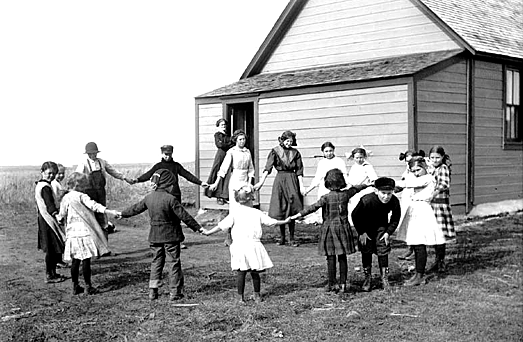
Children have played games for as long as their have been children.
At first, the games were simple tag games and pitching and throwing
games, and of course races. But as time went on, they became more
complex and often influenced by the events occurring at the time.
Human history and games are inextricably intertwined. There’s
evidence throughout history that games weren’t frivolous pursuits
but came naturally to humans as essential parts of being alive.
Going Back to Ancient Times
Dice are probably among the oldest known gaming tools known to man.
During an excavation in Southeastern Iran, archeologists discovered
a 3,000-year-old set of dice. Historians don’t know exactly what
games those early Persians would have played with them, but the
popularity of dice has endured throughout millennia.
There are references to tile games in China that are over 2,900
years old. Dominoes emerged 1,000 years later during the Song
Dynasty. However, Western dominoes probably only began in the 18th
century, and Mahjong, the most popular tile game in the world and
also of Chinese origin), didn’t appear until the 19th century.
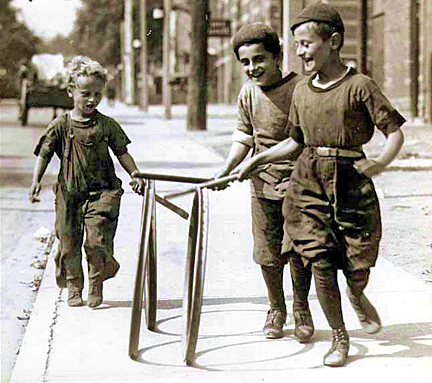 Hoop
rolling is a children’s game that has past into history. It
consisted of two kids —each with a single hoop and a stick—racing
each other from one point to another, although the game can also be
played solo. In the 19th and 20th centuries, the hoop and stick were
made of wood, but in ancient Rome, the trochus, or hoop, and the
clavis, or stick, were made of metal. Roman soldiers would train on
these devices, trying to see how many times they could stick a spear
through the hoop while keeping it rolling. They viewed it as a manly
game.
Hoop
rolling is a children’s game that has past into history. It
consisted of two kids —each with a single hoop and a stick—racing
each other from one point to another, although the game can also be
played solo. In the 19th and 20th centuries, the hoop and stick were
made of wood, but in ancient Rome, the trochus, or hoop, and the
clavis, or stick, were made of metal. Roman soldiers would train on
these devices, trying to see how many times they could stick a spear
through the hoop while keeping it rolling. They viewed it as a manly
game.
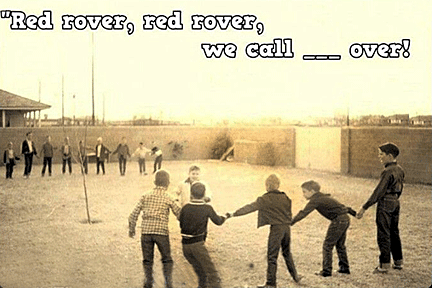 In
the past, adults enjoyed many of the same games children play today.
Take Red Rover, for instance, in which two teams of people stand in
a row with their hands linked. Players take turns running at the
opposing line, attempting to break through. It was a popular adult
game in Victorian times, probably because it could be used to get
around proper social norms and dating customs that involved not
touching anyone of the opposite sex. Some historians believe that
Red Rover, with its distinctive chant, was named after an 1828
steamboat that took passengers back and forth across the Hatchie
River. Another suggests it was a taunt early English children
directed at Viking invaders.
In
the past, adults enjoyed many of the same games children play today.
Take Red Rover, for instance, in which two teams of people stand in
a row with their hands linked. Players take turns running at the
opposing line, attempting to break through. It was a popular adult
game in Victorian times, probably because it could be used to get
around proper social norms and dating customs that involved not
touching anyone of the opposite sex. Some historians believe that
Red Rover, with its distinctive chant, was named after an 1828
steamboat that took passengers back and forth across the Hatchie
River. Another suggests it was a taunt early English children
directed at Viking invaders.
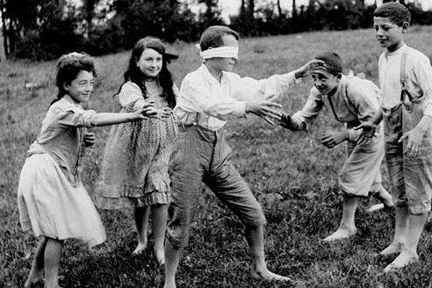 Blind
man's bluff, especially popular in Tudor England, even among adults,
was even said to be a favorite in the court of Henry VIII. It’s a
game that consists of a blindfolded person who is "it" and other
players who either stand around or move at will until they are
tagged. If the person who's "it" correctly identifies someone
they've tagged, that person is the next to be blindfolded.
Blind
man's bluff, especially popular in Tudor England, even among adults,
was even said to be a favorite in the court of Henry VIII. It’s a
game that consists of a blindfolded person who is "it" and other
players who either stand around or move at will until they are
tagged. If the person who's "it" correctly identifies someone
they've tagged, that person is the next to be blindfolded.
Light as a Feather, Stiff as a Board is a kids game that requires
one child to pretend to be deceased while the others lift him or her
up off of the ground with their fingertips. Some people compare it
to the faked seances of the Victorian Era, only for children.
Despite the rise in women's independence during the early 20th
century, there were still social norms in place, particularly in
reference to courting or dating. It was easy to get a bunch of men
and women in one parlor and use the game to get around this, as
"copping a feel" was more easily excused when it was done in under
the guise of fun.
Playground Games
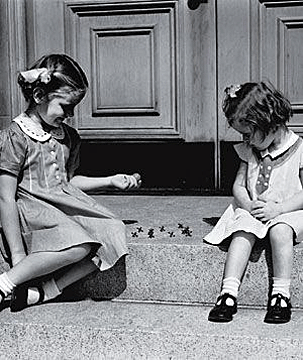 There
are many other childrens’ games that have been passed down through
the centuries. And some border on the bizarre.
There
are many other childrens’ games that have been passed down through
the centuries. And some border on the bizarre.
The game of Jacks dates back to ancient Greece, except at that time
the jacks and ball were tiny sheep bones or rocks. Children still
played it essentially the same way, tossing and catching the jacks
in a prescribed fashion. For most history, children called it
“Knucklebones.”
Just about everyone has played Hopscotch during their childhood.
Some historians believe that it began in Roman-ruled England. The
original courses extended for 100 feet. Roman soldiers used them to
build agility while wearing full armor. The “scotch” in hopscotch
attached itself later. It’s an English variation of “scratch,” in
that players hopped over scratches made on the ground.
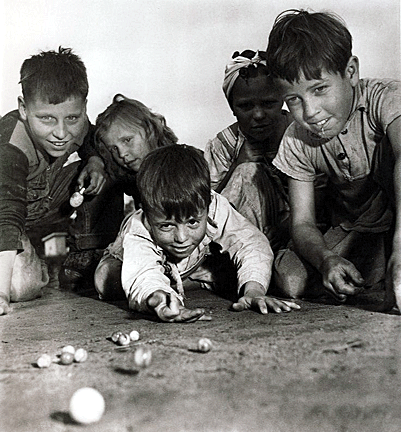 Marbles
have been found in the tombs of Egyptian Pharaohs and in Aztec
ruins. There is no one way to play them. The classic version
originated in the early part of the 20th century, when
mass-production made it possible for children to buy whole bags of
beautiful glass marbles for pennies.
Marbles
have been found in the tombs of Egyptian Pharaohs and in Aztec
ruins. There is no one way to play them. The classic version
originated in the early part of the 20th century, when
mass-production made it possible for children to buy whole bags of
beautiful glass marbles for pennies.
Historians generally disagree on the origin of the game Mumblypeg.
It originated in 17th-century England or 19th-century America. Mark
Twain mentioned it as one of Tom Sawyer’s favorite activities, and
the image of young boys tossing pocketknives at their feet and then
removing them from the dirt with their teeth, making them “mumbly,”
feels very like Twain.
The London Bridge has existed in one form or another since the Roman
occupation of Britain—and it has fallen down many times. Some
believe the game of London Bridge is Falling Down that accompanies
the rhyme grew from a widespread tradition of bridge dances popular
in the Middle Ages. Some historians also believe that the rhyme,
itself, refers to a superstitious practice of killing and burying a
child at the bridge site to keep it from collapsing.
Though no one has traced the precise beginning of Capture the Flag,
it’s most likely a child’s re-creation of a battlefield on which the
battle is not won until a player is in possession of the opponent’s
flag.

Historians believe that the game of Double Dutch, where children
jump ropes whirled opposite to each other, evolved from the way
ancient rope makers made their ropes. Workers would tie the ropes to
their waists and a large wheel, wrapping strands as they walked
backwards. Supply runners would have to jump these ropes when slack
to make their deliveries.
The game of Foursquare also has ancient origins, but the version
children play today became popular after the 1940s. It was
originally called “boxball” because of the quadrants used and was
especially popular in cities where there wasn’t enough room to play
other traditional ball games.
Tetherball is either an offshoot of the romantic “Maypole,” or it
evolved from a game played by the Tartars in the 9th century that
was a lot like tetherball but used pieces of vanquished enemies as
the ball.

Finally, there’s the schoolyard and sidewalk game of Red Light/Green
Light. In this game, one child plays the "stop light" and the rest
try to touch him or her. At the start, all the children form a line
about 15 feet away from the stop light. The stop light faces away
from the line of kids and says "green light." When those in linen
hear that, they can move forward. At any point, the stop light may
say "red light!" and turn around. If any of the kids are caught
moving after this has occurred, they’re out. Play resumes when the
stop light turns back around and says "green light." The stop light
wins if all the kids are out before anyone is able to touch him or
her. Otherwise, the first player to touch the stop light wins the
game and earns the right to be "stop light" for the next game.
